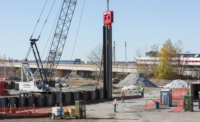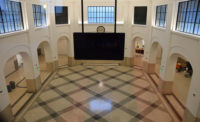Before construction of the MGM Springfield resort casino in Western Massachusetts could even begin in March 2015, crews had their hands full setting the table for the $950-million mixed-use project. In one year, they relocated a homeless mission, moved a 400-ton historic church and planned for demolition of an old school and a 1970s car wash, among some 20 structures on the three-city-block site that needed to be demolished, restored or partially retained.
In summer 2015 alone, the project team spent three months building a 60-bed mission facility off site so its 30 residents could move before demolition of the Springfield Rescue Mission building “that was smack dab in the middle of the casino floor [location],” says Eric Nelson, project executive for general contractor AECOM Tishman.
Then in April 2016, the First Spiritualist Church, a 129-year-old Huguenot church listed on the National Register of Historic Places, was lifted onto computerized hydraulic dollies and moved 600 ft to a new foundation to create space on the tight 14-acre site with multiple staging yards and closely scheduled deliveries. The team also spent a year discontinuing portions of some roadways, closing others and relocating parking lots for the courthouses around the site before redirecting traffic flow to create one open jobsite.
In fact, logistics for preconstruction and the enabling phases, including utility work, was so complicated that the team implemented a customized coordination system. Using PDF backgrounds and Bluebeam software, they created a grid that prioritizes work in 11 zones to sequence and phase the project. The casino is scheduled to open in fall 2018.
Ultimately, the structure will anchor the city’s South End, while rehabilitation of the $94-million Union Station, completed in June, anchors the North End. The casino complex combines new construction with revived historic buildings that will provide more than 125,000 sq ft of gaming space, a 250-room boutique hotel on Main Street and a spa, in addition to dining and retail venues and a child care facility outside the footprint of the resort. The project, anticipated to achieve LEED-Gold certification, also includes a cinema, a bowling complex and a seasonal outdoor skating rink that will serve as a marketplace for art exhibits and events in warmer months.
A Springfield native who moved home for the first time in 20 years to build the casino, Nelson takes pride in helping the project exceed state-mandated diversity targets for design and construction commitments. While the team’s goals were to contract 10% women-, 5% minority- and 2% veteran-owned businesses, the project achieved 16.6%, 7.7% and 5.3%, respectively, as of March 31. It also cleared workforce diversity goals, with 10.27% women workers, 24.07% minorities and 10.37% veterans.
“It’s a cool job, and it’s a big job for Springfield,” Nelson says.
Foundations and Facades
The project team was required to save the facades of the former Union Chandler Hotel building and 73 State Street, the old United Electric building designed in the Beaux Arts style by Boston architect Thomas M. James.
The team also created an entirely new foundation for the Union Chandler facade and transferred structural loads to the new structure, collaborating with structural engineering consultants DeSimone and Sanborn Head for geotechnical work.
Working in Springfield’s Connecticut River basin presented challenges since the historic hotel foundation rests on a fine, silty layer of sand 15 ft beneath the surface. The team didn’t want to undermine existing foundations or infrastructure with excess loads or vibrations. That includes an old 72-in.-dia brick sewer about 6 ft away on Main Street, says Brian Packer, vice president of construction development for MGM Springfield.
The team hired O’Reilly, Talbot & Olkun as geotechnical consultants to monitor vibrations and Allen & Major Associates Inc. to monitor settlement. “We had to be sure … we weren’t causing the building to settle at all,” Packer says.
Randy Pitts, AECOM Tishman vice president of field operations, says work on the Union Chandler Hotel took a lot of hand demolition utilizing a small German drill rig for pile install. “Working in 5-foot increments,” he says, “we drilled 30 mini piles to refusal [the depth below which a pile cannot be driven] and cast a continuous pile cap before sequentially conducting demolition.”
Pio Monsini, AECOM Tishman superintendent, says the team had to make a trough for a complete separation of the hotel’s wooden building. “The floor joints and beam timbers that entered the front wall had to be cut free and every floor below it had to be properly shored,” he says. Using a high-reach excavator with a 180-degree rotating grapple, demo crews removed the building from top to bottom, finishing a week ahead of schedule.
The “tensest moment” of the operation was when the excavator turned the corner around the outside walls near Main Street and the existing masonry building “that only had a thin saw cut in the wall,” Monsini says. “We didn’t have an opportunity to create a trough .… Peeling away the brick was a surgical operation.”
Work on each building has required safely cutting and separating the historic facades from their existing buildings and then structurally supporting those freestanding facades during removal of the old buildings and reintegration of the preserved facades into the new structure, Packer explains. The Union Chandler facade will be integrated back into the new hotel while 73 State Street will become part of the marketplace entertainment complex.
One day last June, the Union Chandler facade removal work began at 5:30 a.m. and ended 12 hours later. Crews severed 15-ft by 40-ft I-beams in place. “We cut a slash so the beam would sit back on itself rather than drop out if there were to be settlement,” Pitts recalls. “When the building was finally separated 12 hours later, we began the intense monitoring .… We had no movement for two weeks. It was amazing.”
Late March 2016 marked the beginning of the foundation and earthwork phase for the casino complex itself. Federal Concrete performed footing and foundation work for the 3,400-car garage and podium while S&F Concrete completed all the podium and casino work, including for the hotel. Pitts says the foundations and the 5,000-ton steel superstructure were completed in May.
Currently, framing for the exterior walls and roofing for the central utility plant, including mechanical distribution piping work, is underway for the casino, hotel, podium and entertainment complex, Pitts adds, noting that the garage is substantially complete.
Preserving Springfield
MGM has stated it is committed to a casino design that distinguishes itself from existing gaming facilities while blending with Springfield’s historic architecture and flowing onto Main Street to create economic benefits well beyond the resort’s footprint.
Kevin Kennedy, chief development officer of the Springfield Redevelopment Authority, says unlike traditional casinos designed to resemble fortresses, the six-story, block-long building designed by the Friedmutter Group looks “more like Springfield than anything else.”
Packer says to preserve the look and feel of historic Springfield, such as the re-creation of the old wood, windows and sashes of the YWCA building and the Union Chandler Hotel, MGM spent a year and a half in negotiations with the city and state to decide what historic resources should be saved, preserved or relocated.
AECOM Tishman is currently working with MGM on the 120-year-old National Guard Armory, a central building for the resort that will become a venue for dining and nightlife. Crews are currently completing abatement and interior demolition before they fit it back out for adaptive reuse. The team’s goal is to “make the outside look and feel like the original armory while creating something fresh and new inside,” Packer says.
The building is one of multiple structures that were ravaged by a 2011 tornado. “In one area, crews took down the drill hall and a chimney,” Nelson says. “Some key elements, including the fireplace, will be reused, but the building will be gutted so we’ll have to reinforce the extremely heavy turret structures in place.”
He added, “It’s a complicated, but fun job that takes a lot of planning.”










